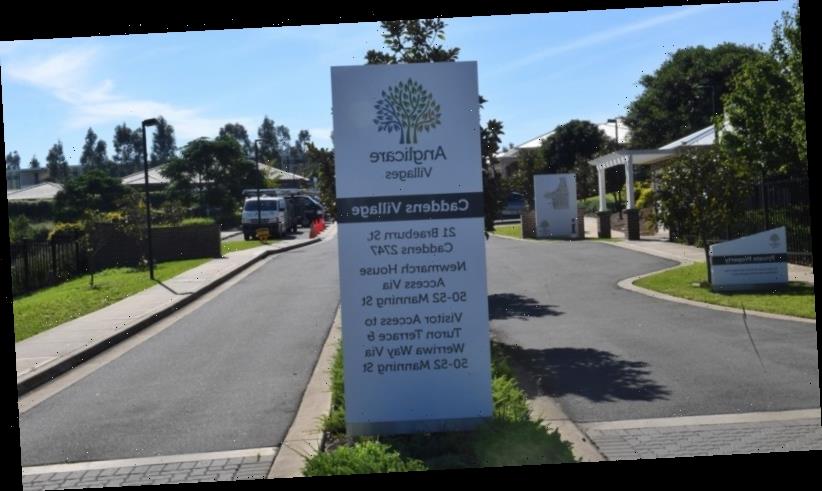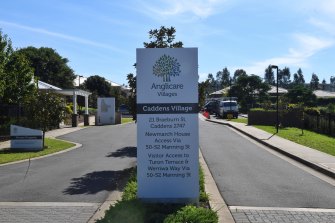Some of Australia's biggest not-for-profit nursing home providers are claiming financial harship to argue they need millions of dollars in extra government funding even though they are generating large cash surpluses.
While smaller nursing homes – still the bulk of the industry in Australia – are genuinely struggling according to analysis from the Centre for International Corporate Tax Accountability and Research, the financial reports of the largest church and charity-run nursing home businesses show they are "generating substantial incomes".
Anglicare, whose Newmarch House suffered a COVID-19 outbreak, is one of the non-profit organisations featured in a new report.Credit:Nick Moir
Between them, nine large operators examined in the report generated $180 million in net cash from operations and invested tens of millions in property from their aged care revenues "to expand their business," author Jason Ward wrote.
"Four out of five of the largest non-profit residential aged care operators claimed losses in 2019," he wrote, while "each produced at least $26 million in net cash flow from operations … largely from residential aged care".
"Losses are used to justify calls for increased federal funding," said Mr Ward, an adjunct senior researcher with the University of Tasmania’s Institute for the Study of Social Change.
A recent report from aged care accountant StewartBrown showed that 60 per cent of Australian aged care homes recorded an operating loss in the nine months to March and the aged care royal commission's recent report on funding and finance referred to the need for a 50 to 100 per cent increase in funding.
But Mr Ward said the accounts showed large operators were "hiding behind" aggregate industry figures.
"These operators, which dominate peak bodies and influence government policy and regulation, use overall industry figures to demand more funding which they are better positioned to capture."
However, Mr Ward said it was difficult to make firm judgments about the true financial position of some of the largest charitable and religious organisations because their accounts are not "Tier 1" under Australian accounting standards, and therefore lack detailed explanations.
The two industry groups representing not-for-profit organisations both said their members supported financial transparency and complied with their reporting requirements through the Australian Charities and Not-for-Profits Commission.
The focus on growth may come at the expense of providing high quality care for elderly Australians.
Leading Age Services Australia chief executive Sean Rooney said some organisations "undertake other ventures to generate returns that can be reinvested back into their charitable activities".
And Patricia Sparrow, the chief executive of Aged and Community Services Australia, said the sector existed "to provide care in the community and returns any surplus to achieving this key, essential purpose". Property investments were "so that accommodation and care needs of our elderly residents in the community can be met".
Mr Ward said many non-profits, like for-profit entities, undertook cross-party transactions, some involving trusts, and were overseen by boards "dominated by current and former corporate executives". While there's no suggestion that any of those transactions are illegitimate, they are difficult to track and scrutinise.
"The focus on growth may come at the expense of providing high quality care for elderly Australians," he wrote. "As consolidation continues and smaller operators are forced out of the market, the lack of transparency and accountability is a growing concern."
Mr Ward profiled nine of the largest not-for-profit homes across the country, including Blue Care, Uniting Care, Bolton Clarke, Catholic Healthcare, Anglicare in NSW, Mercy Aged and Community Care and Southern Cross Care.
Blue Care, the Uniting Church's aged, disability and community care organisation in Queensland, for example, had revenues in 2019 of $1.5 billion, larger than Sydney Airport's, with 39 per cent of it coming from federal government funding. It had positive cash flow of more than $60 million, but a $90 million investment, mostly in property, meant it reported a $30 million loss.
Despite this, a related company had $254.5 million in cash on deposit. Other money flowing into and out of related trusts were also unexplained in the accounts, the report said.
A spokesperson for Blue Care said it "supports greater financial transparency," and its own accounts met current requirements.
Catholic Healthcare Limited made more than $130 million in investments in 2019 to grow its business. By the end of 2020 it will control $2 billion in financial assets.
Catholic Healthcare said it was expanding because "the Government is urging providers to respond to the significantly increased demand for aged care over the coming decade," and the organisation was "seeking to play our part".
And Anglicare, which runs the COVID-19-hit Newmarch House in Sydney, reported a loss of $16 million after spending $171 million on property, plant and equipment. It also relied heavily on agency workers, which made up 9 per cent of its employee costs, the report said.
A spokesperson said, “Anglicare Sydney uses its resources to care for the elderly and vulnerable across our society”, but without having seen the report the organisation could not comment further.
The report into non-profit aged care operators comes in the wake of revelations that the owners of Heritage Care, which was not the subject of this report, a COVID-19-hit private, for-profit nursing home company with facilities in NSW and Victoria, had become multimillionaires from running nursing homes, and were leading lavish lifestyles including luxury cars and richly decorated mansions.
COVID-19 is ripping through both for-profit and not-for-profit nursing homes in Victoria, with 2018 active infections linked to them on Wednesday.
Get our Morning & Evening Edition newsletters
The most important news, analysis and insights delivered to your inbox at the start and end of each day. Sign up to The Sydney Morning Herald’s newsletter here, The Age’s newsletter here, Brisbane Times‘ here and WAtoday’s here.
Source: Read Full Article

